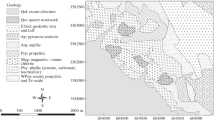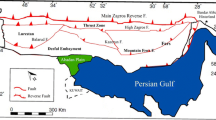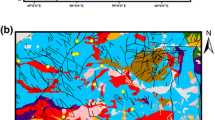Abstract
The rapid and accurate identification of the formation lithology encountered during the drilling of oil and gas fields is an important step to control the trajectory of the drilling tool borehole and improve the optimal reservoir encounter rate. At present, the main way to distinguish the lithology of the formation encountered by drilling is to use artificial detection elements, which does not form a set of intelligent formation identification system. In view of the above problems, this paper proposes a method to identify the lithology of drilled formation by using element and gamma spectrum measurement and establishes a reasoning model of intelligent identification of formation lithology by using improved fuzzy clustering algorithm-SVM (IFCM-SVM) method. Field application shows that the accuracy of IFCM-SVM intelligent formation identification method proposed in this paper can reach 90.9%, and verifies the feasibility of using element and gamma spectrum measurement to realize the intelligent identification of formation lithology in drilling.









Similar content being viewed by others
References
Liu N, Wang G (2016) Shale gas sweet spot identification and precise geo-steering drilling in Weiyuan Block of Sichuan Basin, SW China. Pet Explor Dev 43:1067–1075. https://doi.org/10.1016/S1876-3804(16)30124-0
Liu X (2017) Directional deflection equations for steerable drilling tools and the control mechanism of wellbore trajectory. Pet Explor Dev 44:834–839. https://doi.org/10.1016/S1876-3804(17)30094-0
Panchal N, Bayliss MT, Whidborne JF (2012) Attitude control system for directional drilling bottom hole assemblies. IET Control Theory Appl 6:884–892. https://doi.org/10.1049/iet-cta.2011.0438
Xie Y, Zhu C, Zhou W, Li Z, Liu X, Tu M (2018) Evaluation of machine learning methods for formation lithology identification: a comparison of tuning processes and model performances. J Pet Sci Eng 160:182–193. https://doi.org/10.1016/j.perol.2017.10.028
Liang H, Zou J, Li Z, Khan MJ, Lu Y (2019) Dynamic evaluation of drilling leakage risk based on fuzzy theory and PSO-SVR algorithm. Futur Gener Comput Syst 95:454–466. https://doi.org/10.1016/j.future.2018.12.068
Dong S, Wang Z, Zeng L (2016) Lithology identification using kernel Fisher discriminant analysis with well logs. J Pet Sci Eng 143:95–102. https://doi.org/10.1016/j.petrol.2016.02.017
Gürsoy D, Biçer T, Lanzirotti A, Newville MG, De Carlo F (2015) Hyperspectral image reconstruction for X-ray fluorescence tomography. Opt Express 23:9014. https://doi.org/10.1364/oe.23.009014
Elaidi H, Elhaddar Y, Benabbou Z, Abbar H (2018) An idea of a clustering algorithm using support vector machines based on binary decision tree. In: 2018 international conference on intelligent systems and computer vision, ISCV 2018. 2018-May 2018, pp 1–5.https://doi.org/10.1109/ISACV.2018.8354024
Liang H, Zou J (2019) Rock image segmentation of improved semi-supervised SVM–FCM algorithm based on chaos, circuits. Syst Signal Process. https://doi.org/10.1007/s00034-019-01088-z
Cao S-J, Ding J, Ren C (2020) Sensor deployment strategy using cluster analysis of fuzzy C-means algorithm: towards online control of indoor environment’s safety and health. In: Sustainable cities and society. https://doi.org/https://doi.org/10.1016/j.scs.2020.102190.
Gosain A, Dahiya S (2016) Performance analysis of various fuzzy clustering algorithms: a review. Procedia Comput Sci. https://doi.org/10.1016/j.procs.2016.03.014
Qi C, Wang W, Wang S (2015) Application of indoor temperature prediction based on SVM and FCM. In: Proceedings of 2015 27th Chinese control and decision conference CCDC 2015, pp 2883–2887. https://doi.org/10.1109/CCDC.2015.7162418
David P (2020) Hofmeyr, degrees of freedom and model selection for K-means clustering. Comput Stat Data Anal. https://doi.org/10.1016/j.csda.2020.106974
P. Properties, E.B. V All, Rocks—Their Classification and General Properties, (n.d.) 1–16
Ge Z, Song Z, Ding SX, Huang B (2017) Data mining and analytics in the process industry: the role of machine learning. IEEE Access 5:20590–20616. https://doi.org/10.1109/ACCESS.2017.2756872
Shahiri AM, Husain W, Rashid NA (2015) A review on predicting student’s performance using data mining techniques. Procedia Comput Sci 72:414–422. https://doi.org/10.1016/j.procs.2015.12.157
Agrawal S, Agrawal J (2015) Survey on anomaly detection using data mining techniques. Procedia Comput Sci 60:708–713. https://doi.org/10.1016/j.procs.2015.08.220
Li F, Shi C (2018) NO-sensing performance of vacancy defective monolayer MoS2 predicted by density function theory. Appl Surf Sci. https://doi.org/10.1016/j.apsusc.2017.10.167
Jamshidi M, Rezaei O, Belverdi AR, Malekian S, Belverdi AR (2016) A highly selective fluorescent chemosensor for Mg2+ ion in aqueous solution using density function theory calculations. J. Mol Struct. https://doi.org/10.1016/j.molstruc.2016.06.005.
Pronzato L, Wynn HP, Zhigljavsky AA (2018) Simplicial variances, potentials and Mahalanobis distances. J Multivar Anal https://doi.org/10.1016/j.jmva.2018.08.002
de la Hermosa González-Carrato RR (2018) Wind farm monitoring using Mahalanobis distance and fuzzy clustering. Renew Energy 10:526–540
Li Y, Xu M, Zhao H, Huang W (2016) Hierarchical fuzzy entropy and improved support vector machine based binary tree approach for rolling bearing fault diagnosis. Mech Mach Theory 98:114–132. https://doi.org/10.1016/j.mechmachtheory.2015.11.010
Yang X, Yu Q, He L, Guo T (2013) The one-against-all partition based binary tree support vector machine algorithms for multi-class classification. Neurocomputing 113:1–7. https://doi.org/10.1016/j.neucom.2012.12.048
Trajdos P, Kurzynski M (2018) Weighting scheme for a pairwise multi-label classifier based on the fuzzy confusion matrix. Pattern Recognit Lett 103:6067. https://doi.org/10.1016/j.patrec.2018.01.012
Acknowledgements
This work was supported by Sichuan Science and Technology Innovation and Venture Seedling Project, China (No. 2020JDRC0081). At the same time, the work was supported by the graduate innovation fund of southwest petroleum university, China (No. 2019cxyb003).
Author information
Authors and Affiliations
Corresponding author
Ethics declarations
Conflict of interest
We declare that we have no financial and personal relationships with other people or organizations that can inappropriately influence our work; there is no professional or other personal interest of any nature or kind in any product.
Additional information
Publisher's Note
Springer Nature remains neutral with regard to jurisdictional claims in published maps and institutional affiliations.
Rights and permissions
About this article
Cite this article
Zhang, H., Chen, Q., Ni, P. et al. Study on the intelligent identification method of formation lithology by element and gamma spectrum. Neural Comput & Applic 34, 3375–3383 (2022). https://doi.org/10.1007/s00521-021-05714-3
Received:
Accepted:
Published:
Issue Date:
DOI: https://doi.org/10.1007/s00521-021-05714-3




